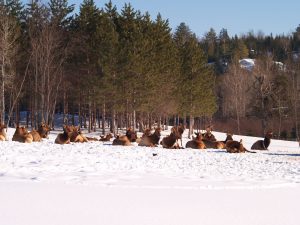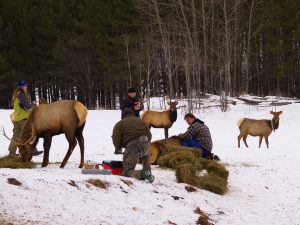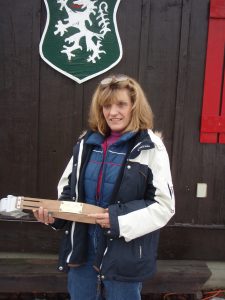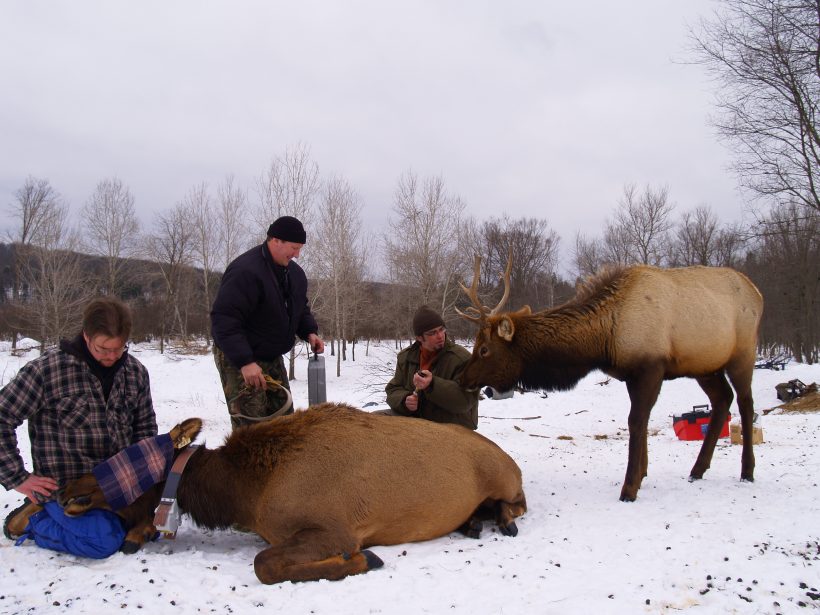Collaring an elk
Dr. Rick Rosatte, head research scientist for the MNR elk re-introduction project in North Hastings, had picked the perfect day. With a high of -2 degrees C it was downright balmy following an old time frigid February deep-freeze featuring temperatures dipping to -30C and colder. There are many reasons for wishing, actually requiring, milder weather when it comes to collaring an elk with a GPS unit. Read on and see if you can’t discover a few.
We were seeking a cow elk. To date Dr. Rosatte has collared 6 bulls. Now, he aimed to collar 6 cows. These GPS units record the travels and daily patterns of elk. Should one die the collar sends out a locator signal. Otherwise, when the research teams needs to recover one of these collars, valued at $4500, they need to find and dart the elk a second time.

Joe Neuhold, locally known as “The Elkman”, oversees 2000 acres. An elk herd of approximately 40 animals live in that area. Each year, during the winter, he puts out two bales of hay each morning and two in the afternoon; in addition to “about half a bag of grain.” He started this year with 500 bales; all paid for out of his own pocket and from contributions of the Quinte Elk Restoration Committee. This makes it much easier for researchers like Dr. Rosatte. When he arrived the elk were already at Joe’s. It was simply a matter of choosing a cow and darting her. Mike Allan, of the Wildlife Section of the MNR, couldn’t believe it. “I’ve only seen them from the air,” he said, in reference to aerial tracking. Kirk Sobey, a Biologist also with the Wildlife Section, echoed the sentiment saying he had “expected to have to search the cold bush for the herd.”
After Dr. Rosatte estimated the weight of the cow Allan and Sobey prepared the appropriate drugs for the dart. At Elk Island, Alberta, where they obtained the elk for their initial local release in 2000, Rosatte became “pretty accurate at guessing their weights after doing about 400 animals.” Even at -2 Allan had some difficulty drawing the drugs out of their bottles with the syringe. It was time to keep the rest next to a warm body.
Once Dr. Rosatte had darted his target it would be an hour before they could apply the antagonist drug. Sometimes an animal would rest as long as an hour and a half before struggling to its feet. But, after the initial hit, we would wait about 15 minutes for the tranquilizer to take effect before moving in.
The first order of business was to fold the elk’s legs underneath with the animal resting upright. Bales of hay supported the body and head. Allan supported the head as well checking the gums for colouring and monitoring the saliva drain, much of which poured over his water repellant pants while he held the head. Sobey also monitored the rate of respiration and carefully removed the dart from the hindquarters where he applied some antiseptic ointment as well as an antibiotic. Regarding drugs, ministry personnel must regularly take a 4 day requalification course and pass the exam with a minimum of 80%. (What to do if you accidentally inject yourself is just one of many areas of study.) Allan applied a cloth over the elk’s eyes as well as some ointment for protection and Dr. Rosatte replaced the old collar with the new GPS unit. Allan, Sobey and Rosatte carefully stored the drug paraphernalia for later disposal.

TLC (tender loving care) was the order of the day carefully watching over the cow after the antagonistic drug was administered to hasten the recovery. Six or seven bulls, attracted by a free meal, grazed on the hay supporting the cow. First, her ears moved, then the head came up and ultimately she struggled to her feet to stagger and stare. Later, darting a second and younger cow that recovered much faster, Dr. Rosatte theorized that age had something to do with it. Dr. Rosatte still has 4 cows to collar.
A Special Collar
On Tuesday, January 8, 2008, several members of the Quinte Elk Restoration Committee made their way through the pea thick fog for a special gathering meeting at the Elkman’s. Dr. Rick Rosatte and MNR technician Colin Higgins were going to place a tracking collar on one of the elk in memory of Rick Beaudrie, a long time supporter of the elk re-introduction program.
“There wasn’t anything that he wouldn’t do for the elk,” said Sue Beaudrie, Rick’s wife, who was also present. Each year the committee donates collars to the elk research program and committee member Jack Caddick suggested this tribute.
“In addition to being a family friend who hunted with Rick, Jack was instrumental in having the committee honour Rick in this way,” said member Doug Howell. Caddick arranged for a special plaque that was attached to the tracking collar. The entire operation went smoothly with Rosatte and Higgins darting a fine bull elk and attaching the collar.

